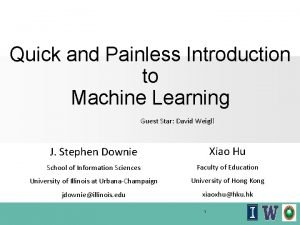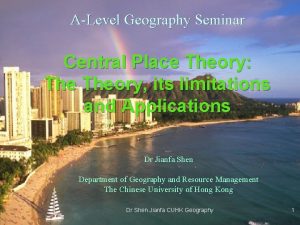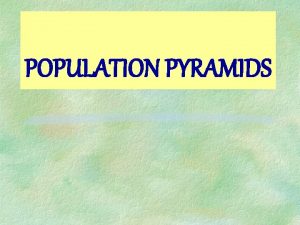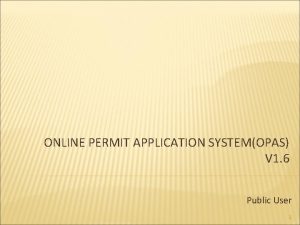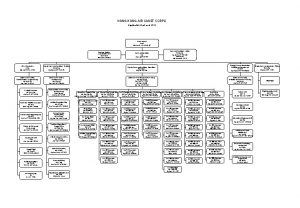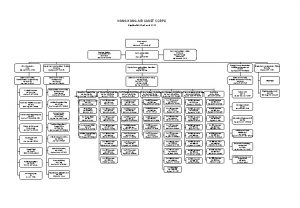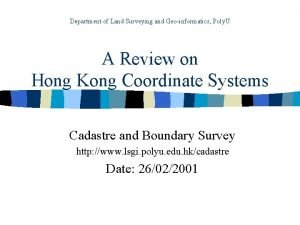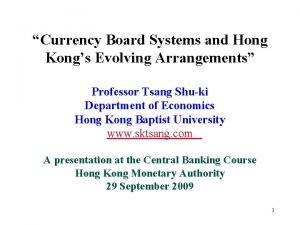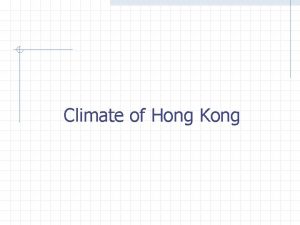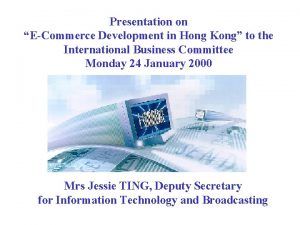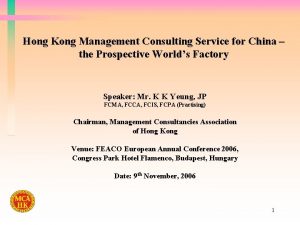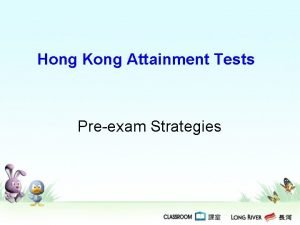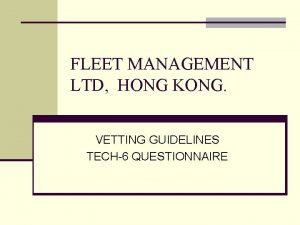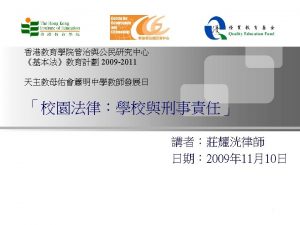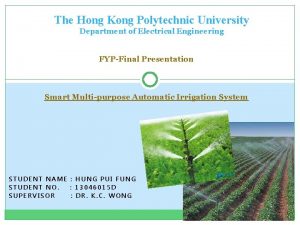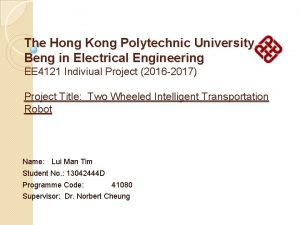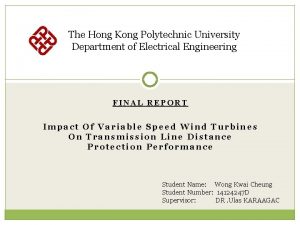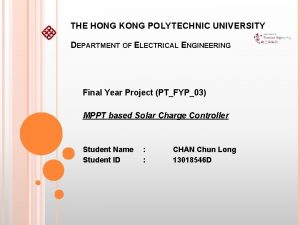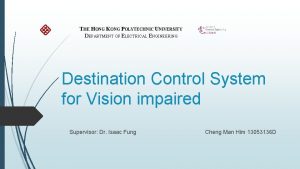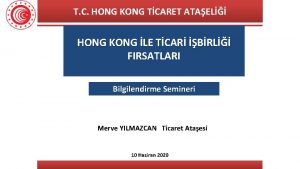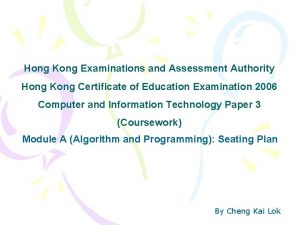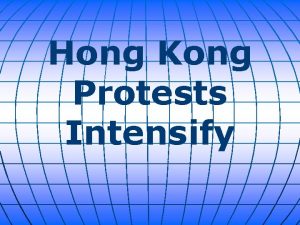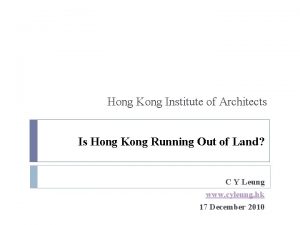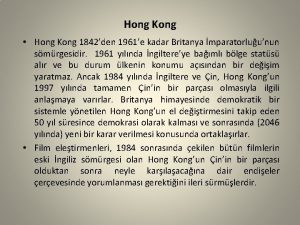Hong Kong Polytechnic University Electrical Charge Some Concepts































- Slides: 31

Hong Kong Polytechnic University Electrical Charge Some Concepts: Electrical charge (电荷); Electric field (电场); Electric current (电流); Conductor (导体 ); Semiconductor (半导体); Insulator (绝缘体); Superconductor (超导体); Two Fundamental Properties of Electrical Charge: Charge is quantized: ; Charge is conserved: Electrostatic Force: permittivity constant (介电常数): Note that this satisfies Newton's third law because it implies that exactly the same magnitude of force acts on q 2. Coulomb's law is a vector equation and includes the fact that the force acts along the line joining the charges. Like charges repel and unlike charges attract. Coulomb's law describes a force of infinite range which obeys the inverse square law, and is of the same form as the gravity force. Shell Theorem: A shell of uniform charge attracts or repels a charged particle that is outside the shell as if all the shell’s charge were concentrated at its center. A shell of uniform charge exerts no electrostatic force on a charged particle that is located inside the shell. College Physics----by Dr. H. Huang, Department of Applied Physics 1

Hong Kong Polytechnic University Electrical Charge Spherical Conductors: If excess charge is placed on a spherical shell that is made of conducting material, the excess charge spreads uniformly over the external surface. Example: The figure shows two particles fixed in a place: a particle of charge q 1=+8 q at the origin of an x axis and a particle of charge q 2=-2 q at x=L. At what point (other than infinitely far away) can a proton be placed so that it is in equilibrium? Is that equilibrium stable or unstable? Solution: Example: The arrangement of six fixed charged particles, where =30 , is shown. All six particles have the same magnitude of charge q; their electrical signs are as indicated. What is the net electrostatic force acting on q 1 due to the other charges? Solution: 0 College Physics----by Dr. H. Huang, Department of Applied Physics 2

Hong Kong Polytechnic University Electrical Charge Example: Two identical, electrically isolated conducting spheres A and B are separated by a (center-to-center) distance a that is large compared to the spheres. Sphere A has a positive charge of +Q; sphere B is electrically neutral; and initially, there is no electrostatic force between the spheres. (a) Suppose the spheres are connected for a moment by a conducting wire. The wire is thin enough so that any net charge on it is negligible. What is the electrostatic force between the spheres after the wire is removed? (b) Next, suppose sphere A is grounded momentarily, and then the ground connection is removed. What now is the electrostatic force between the spheres? Solution: College Physics----by Dr. H. Huang, Department of Applied Physics 3

Hong Kong Polytechnic University Electrical Charge Homework: 1. The figure shows two charges, q 1 and q 2, held in a fixed distance d apart. (a)What is the magnitude of the electrostatic force that acts on q 1? Assume that q 1=q 2=20. 0 C and d=1. 50 m. (b)A third charge q 3=20. 0 C is brought in and placed as shown in the figure. What now is the magnitude of the electrostatic force on q 1? 2. In the basic Cs. Cl (cesium chloride) crystal structure, Cs+ ions form the corners of a cube and a Cl ion is at the cube’s center. The edge length of the cube is 0. 40 nm. The Cs+ ions are each deficient by one electron (and thus each has a charge of +e), and the Cl ion has one excess electron (and thus has a charge of –e). (a) What is the magnitude of the net electrostatic force exerted on the Cl ion by the eight Cs+ ions at the corners of the cube? (b)If one of the Cs+ ions is missing, the crystal is said to have a defect; what is the magnitude of the net electrostatic force exerted on the Cl ion by the seven remaining Cs+ ions? College Physics----by Dr. H. Huang, Department of Applied Physics 4

Hong Kong Polytechnic University Electric Fields Electric Field Electric field is defined as the electric force per unit charge. The direction of the field is taken to be the direction of the force it would exert on a positive test charge. The electric field is radially outward from a positive charge and radially in toward a negative point charge. Conversely, the electrostatic force acting on a particle with a charge q is Electric Field of Point Charge: A positive number is taken to be an outward field; the field of a negative charge is toward it. The electric field from any number of point charges can be obtained from a vector sum of the individual fields. College Physics----by Dr. H. Huang, Department of Applied Physics 5

Hong Kong Polytechnic University Electric Fields Example: The figure shows three particles with charges q 1=+2 Q, q 2= 2 Q, and q 3= 4 Q, each a distance d from the origin. What net electric field E is produced at the origin? Solution: Example: The nucleus of a uranium atom has a radius R of 6. 8 fm. Assuming that the positive charge of the nucleus is distributed uniformly, determine the electric field at a point on the surface of the nucleus due to that charge. Solution: The atomic number Z=92 College Physics----by Dr. H. Huang, Department of Applied Physics 6

Hong Kong Polytechnic University Electric Fields Electric Field Lines (电力线): Electric field lines provide a means for visualizing the direction and magnitude of electric fields. The electric field vector at any point is tangent to a field line through that point. The density of field lines in any region is proportional to the magnitude of the electric field in that region. Field lines originate on positive charges and terminate on negative charges. A few examples are shown below: Electric Dipole (电偶极子) Field: An electric dipole consists of two particles with charges of equal magnitude q but opposite sign, separated by a small distance d. It can be proved that the electric field generated by the dipole along the dipole axis is where r is the distance to the center of the dipole r>>d. College Physics----by Dr. H. Huang, Department of Applied Physics 7

Hong Kong Polytechnic University Electric Fields Dipole Moment (偶极矩): p=qd is called the electric dipole moment. It is a vector with a direction pointing from the negative to the positive charge of the dipole. The electric field in a plane perpendicular to the dipole axis that cuts through the dipole by half is Dipole in an Electric Field: The electric field exerts a torque on the dipole The dipole has a potential energy where we choose the potential energy to be zero when the angle is 90. College Physics----by Dr. H. Huang, Department of Applied Physics 8

Hong Kong Polytechnic University Electric Fields Electric Field Due to a Charged Ring: (Optional) As shown in the figure, is the charge per unit length. The total charge on the ring is q. Electric Field Due to a Charged Disk: (Optional) For a uniformly charged disk with a radius R, we can cut the disk into small pieces of rings. Suppose the charge per unit area is , then for each piece of ring, it carries a charge of Each ring contributes an electric field The total field is College Physics----by Dr. H. Huang, Department of Applied Physics 9

Hong Kong Polytechnic University Electric Fields Homework: 1. 2. A clock face has negative point charges –q, 2 q, 3 q, …, 12 q fixed at the positions of the corresponding numerals. The clock hands do not perturb the net field due to the point charge. At what time does the hour hand point in the same direction as the electric field vector at the center of the dial? (Hint: Use symmetry). In the figure a uniform, upward-pointing electric field E of magnitude 2. 00 103 N/C has been set up between two horizontal plates by charging the lower plate positively and the upper plate negatively. The plates have length L=10. 0 cm and separation d=2. 00 cm. An electron is then shot between the plates from the left edge of the lower plate. The initial velocity v 0 of the electron makes an angle =45. 0 with the lower plate and has a magnitude of 6. 00 106 m/s. (a) Will the electron strike one of the plate? (b) If so, which plate and how far horizontally from the left edge? College Physics----by Dr. H. Huang, Department of Applied Physics 10

Hong Kong Polytechnic University Electric Potential Electrical Potential Energy: The electrostatic force is a conservative force. Thus we can define a change of the electric potential energy U of a charged particle in an electric field to be, where W is the work done by the electrostatic force and is path independent. If the potential energy is defined to be zero at infinity, the electric potential energy U of a point charge is U= W , where W is the work done by the electric field on the point charge as the charge moves from infinity to the particular point. Concept: In the figure, a proton moves from point i to point f in a uniform electric field directed as shown. (a) Does the electric field do positive or negative work on the proton? (b) Does the electric potential energy of the proton increase or decrease? E Electrical Potential: f + i The electrical potential energy per unit charge is defined as the electric potential difference (电势差): The electrical potential at a point is ; The unit is volt=joule per coulomb. College Physics----by Dr. H. Huang, Department of Applied Physics 11

Hong Kong Polytechnic University Electric Potential Equipotential Surfaces (等势面): Adjacent points that have the same electric potential form an equipotential surface, which can be either an imaginary surface or a real, physical one. (i) No work is done by the electric field when a charge is moved on that surface. (ii) The electric field E is always directed perpendicularly to the equipotential surface. Potential Calculated from the Field: In a uniform electric field E, the potential difference is, College Physics----by Dr. H. Huang, Department of Applied Physics 12

Hong Kong Polytechnic University Electric Potential due to a Point Charge: Example: (a) What is the electric potential V at a distance r=2. 12 10 -10 m from the nucleus of a hydrogen atom (the nucleus consists of a single proton)? (b) What is the electric potential energy U in electron-volts of an electron at the given distance from the nucleus? (c) If the electron moves closer to the proton, does the electric potential energy increase or decrease? Solution: (c): V increases and U decreases. Example: What is the potential at point P, located at the center of the square of point charges shown in the figure? Assume that d=1. 3 m and that the charges are q 1=+12 n. C, q 2= 24 n. C, q 3=+31 n. C, q 4=+17 n. C. Solution: College Physics----by Dr. H. Huang, Department of Applied Physics 13

Hong Kong Polytechnic University Electric Potential Example: (a) In figure a, 12 electrons are equally spaced and fixed around a circle of radius R. Relative to V=0 at infinity, what are the electric potential and electric field at the center C of the circle due to these electrons? (b) If the electrons are moved along the circle until they are nonuniformly spaced over a 120 are (figure b), what then is the potential at C? Solution: Potential of Line Charge: (Optional) It can be found by superposing the point charge potentials of infinitesmal charge elements. It is an example of a continuous charge distribution. College Physics----by Dr. H. Huang, Department of Applied Physics 14

Hong Kong Polytechnic University Electric Potential for Ring of Charge: (Optional) It can be found by superposing the point charge potentials of infinitesmal charge elements. The ring potential can then be used as a charge element to calculate the potential of a charged disc. Potential for Disc of Charge: (Optional) It can be found by superposing the point charge potentials of infinitesmal charge elements. The evaluation of the potential can be facilitated by summing the potentials of charged rings. Calculating E from V: College Physics----by Dr. H. Huang, Department of Applied Physics 15

Hong Kong Polytechnic University Electric Potential Energy of a System of Point Charges: The electric potential energy of a system of fixed point charges is equal to the work that must be done by an external agent to assemble the system, bringing each charge in from an infinite distance. For two point charges: For many point charges: Example: Starting with the expression for the potential at any point on the axis of a charged disk, derive the expression for the electric field at any point on the axis of the disk. Solution: Example: The figure shows three charges held in fixed positions by forces that are not shown. What is the electric potential energy of this system of charges? Assume that d=12 cm and that q 1=+q, q 2= 4 q, and q 3=+2 q, in which q=150 n. C. Solution: College Physics----by Dr. H. Huang, Department of Applied Physics 16

Hong Kong Polytechnic University Electric Potential Homework: 1. 2. 3. In a given lightning flash, the potential difference between a cloud and the ground is 1. 0 109 V and the quantity of charge transferred is 30 C. (a) What is the change in energy of that transferred charge? (b) If all the energy released by the transfer could be used to accelerate a 1000 kg automobile from rest, what would be the automobile’s final speed? (c) If the energy could be used to melt ice, how much ice would it melt at 0 C? The heat of fusion of ice is 3. 33 105 J/kg. For the charge configuration of the figure, show that V(r) for points such as P on the axis, assuming r>>d, is given by (Note: the charges should be treated as point charges and their size being neglected. ) r q d + +q P College Physics----by Dr. H. Huang, Department of Applied Physics 17

Hong Kong Polytechnic University Capacitance Capacitor: A capacitor is a device that stores electric potential energy by storing separated positive and negative charges. It consists of two conductors separated by either vacuum or an insulating material. The simplest case is a parallel plate capacitor. Capacitance is defined in terms of charge storage: (Farad, F) where, Q = magnitude of charge stored on each plate. V = voltage applied to the plates. Cylindrical Capacitor: (Optional) The charge resides on the outer surface of the inner conductor and the inner wall of the outer conductor. Assume the length of the cylinder L>>b. College Physics----by Dr. H. Huang, Department of Applied Physics 18

Hong Kong Polytechnic University Capacitance Spherical Capacitor: (Optional) An Isolated Sphere: (Optional) By taking the limits: a R and b , Concept: For capacitors charged by the same battery, does the charge stored by the capacitor increase, decrease, or remain the same in each of the following situations? (a) The plate separation of a parallel capacitor is increased. (b) The radius of the inner cylinder of a cylindrical capacitor is increased. (c) The radius of the outer spherical shell of a spherical capacitor is increased. Example: The plates of a parallel-plate capacitor are separated by a distance d=1. 0 mm. What must be the plate area if the capacitance is to be 1. 0 F? Solution: Example: A storage capacitor on a random memory (RAM) chip has a capacitance of 55 f. F. If the capacitor is charged to 5. 3 V, how many excess electrons are on its negative plate? Solution: College Physics----by Dr. H. Huang, Department of Applied Physics 19

Hong Kong Polytechnic University Capacitance Capacitors in Parallel and Series: Equivalent capacitance: Example: (a) Find the equivalent capacitance of the combination as shown. Assume C 1=12. 0 F, C 2=5. 30 F, C 3=4. 50 F. (b) A potential difference V=12. 5 V is applied to the input terminals. What is the charge on C 1? Solution: (a): (b): Example: A 3. 55 F capacitor C 1 is charged to a potential difference V 0=6. 30 V, using a 6. 30 V battery. The battery is then removed and the capacitor is connected as in the figure to an uncharged 8. 95 F capacitor C 2. When switch S is closed, charge flows from C 1 to C 2 until the capacitors have the same potential difference V. What is the common potential difference? Solution: College Physics----by Dr. H. Huang, Department of Applied Physics 20

Hong Kong Polytechnic University Capacitance Potential Energy and Energy Density: The electric potential energy of a capacitor is the energy stored in the electric field between the two plates (electrodes). It is the work required to charge the capacitor. The energy density is the potential energy per unit volume. The above results hold generally for types of capacitors. Example: An isolated conducting sphere whose radius R is 6. 85 cm has a charge q=1. 25 n. C. (a) How much potential energy is stored in the electric field of this charged conductor? (b) What is the energy density at the surface of the sphere? (c) What is the radius R 0 of an imaginary spherical surface such that half of the stored potential energy lies within it? Solution: College Physics----by Dr. H. Huang, Department of Applied Physics 21

Hong Kong Polytechnic University Capacitance Dielectrics: Dielectric material contains polar molecules (or being polarized under an electric field), they will generally be in random orientations when no electric field is applied. An applied electric field will polarize the material by orienting the dipole moments of polar molecules. This decreases the effective electric field between the plates and will increase the capacitance of the parallel plate structure. The dielectric must be a good electric insulator so as to minimize any DC leakage current through a capacitor. is called the dielectric constant of a material. In a region completely filled by a material of dielectric constant , all electrostatic equation containing the permittivity constant 0 are to be replaced by 0. The Guass’ law need to be generalized to, College Physics----by Dr. H. Huang, Department of Applied Physics 22

Hong Kong Polytechnic University Example: A parallel-plate capacitor whose capacitance C is 13. 5 p. F is charged to a potential difference V=12. 5 V between its plates. The charging battery is now disconnected and a porcelain slab is slipped between the plates. What is the potential energy of the device, both before and after the slab is introduced? Solution: Capacitance Room temperature dielectric constants for some materials Material Air (1 atm) 1. 00054 Polystyrene 2. 6 Paper 3. 5 Transformer oil 4. 5 Pyrex 4. 7 Ruby mica 5. 4 Porcelain 6. 5 Silicon 12 Germanium 16 Ethanol 25 Water (20°C) 80. 4 Water (25°C) 78. 5 Titania ceramic 130 Strontium titanate 310 College Physics----by Dr. H. Huang, Department of Applied Physics 23

Hong Kong Polytechnic University Capacitance Example: The figure shows a parallel-plate capacitor of plate area A and plate separation d. A potential difference V 0 is applied between the plates. The battery is then disconnected, and a dielectric slab of thickness b and dielectric constant is placed between the plates as shown. Assume, A=115 cm 2, d=1. 24 cm, V 0=85. 5 V, b=0. 780 cm, =2. 61. (a) What is the capacitance C 0 before the dielectric slab is inserted? (b) What free charge appears on the plates? (c) What is the electric field E 0 in the gaps between the plate and the dielectric slab? (d) What is the electric field E 1 in the dielectric slab? (e) What is the potential difference V between the plates after the slab has been introduced? (f) What is the capacitance with the slab in place? Solution: College Physics----by Dr. H. Huang, Department of Applied Physics 24

Hong Kong Polytechnic University Capacitance Homework (continued): 1. The figure shows a variable “air gap” capacitor. Alternate plates are connected together; one group is fixed in position and the other group is capable of rotation. Consider a pile of n plates of alternate polarity, each having an area A and separated from adjacent plates by a distance d. Show that this capacitor has a maximum capacitance of C=(n-1) 0 A/d. 2. In the figure, battery B supplies 12 V. (a) Find the charge on each capacitor first when only switch S 1 is closed and (b) later when switch S 2 is also closed. Take C 1=1. 0 F, C 2=2. 0 F, C 3=3. 0 F, and C 4=4. 0 F. 3. A parallel-plate capacitor of plate area A is filled with two dielectrics as shown in the figure. Show that the capacitance is 4. A parallel-plate capacitor of plate area A is filled with two dielectrics of the same thickness as shown in the figure. Show that the capacitance is 1 2 2 1 College Physics----by Dr. H. Huang, Department of Applied Physics 25

Hong Kong Polytechnic University Current and Resistance Current: An electric current in a conductor is (ampere, A) A current direction is the one in which positive charge carriers would move. The negative charges move in the opposite direction. Current Density: Drift of Charge Carriers: When an electric field E is established in a conductor, the charge carriers (assumed positive) acquire a drift speed vd in the direction of E, where n is the number of charge carriers per unit volume. Example: (a) The current density in a cylindrical wire of radius R=2. 0 mm is uniform across a cross section of the wire and is given by J=2. 0 105 A/m 2. What is the current through the outer portion of the wire between radial distance R/2 and R? (b) Suppose, instead, that the current density through a cross section varies with radial distance r as J=ar 2, in which a=3. 0 1011 A/m 4 and r is in meters. What now is the current through the same outer portion of the wire? Solution: College Physics----by Dr. H. Huang, Department of Applied Physics 26

Hong Kong Polytechnic University Current and Resistance Example: One end of an aluminum wire whose diameter is 2. 5 mm is welded to one end of copper wire whose diameter is 1. 8 mm. The composite wire carries a steady current i of 17 m. A. (a) What is the current density in each wire? (b) What is the drift speed of the conduction electrons in the copper wire? Assume that, on the average, each copper atom contributes one conduction electron. Solution: Example: Consider a strip of silicon that has a rectangular cross section with width w=3. 2 mm and height h=250 m, and through which there is a uniform current i of 5. 2 m. A. The silicon has a number of charge carriers (electrons) per unit volume n=1. 5 1023 m-3. (a) What is the current density in the strip? (b) What is the drift speed? Solution: Concept: The figure shows conduction electrons moving leftward through a wire. Are the following leftward or rightward: (a) the current i, (b) the current density J, (c) the electric field E in the wire? College Physics----by Dr. H. Huang, Department of Applied Physics 27

Hong Kong Polytechnic University Resistance: (ohm, ) Current and Resistance Resistivity of some materials at room temperature ( m) (K-1) Resistivity: unit of : m Material Silver 1. 62 10 -8 4. 1 10 -3 Conductivity: ( -1 m-1) Copper 1. 69 10 -8 4. 3 10 -3 Aluminium 2. 75 10 -8 4. 4 10 -3 Tungsten 5. 25 10 -8 4. 5 10 -3 Iron 9. 68 10 -8 6. 5 10 -3 Platinum 10. 6 10 -8 3. 9 10 -3 The resistivity for most materials changes with temperature Manganin 48. 2 10 -8 -70 10 -3 Pure Silicon 2. 5 103 is the mean temperature coefficient of resistivity. n-type Silicon 8. 7 10 -4 Ohm’s Law: p-type Silicon 2. 8 10 -3 The resistivity R of a conducting wire of length L and uniform cross-section A is Glass 10 -10 The current through a device is always directly Fused quartz 1016 proportional to the potential difference applied to the device. A conducting material or device obeys Ohm’s law when the resistivity is independent of the magnitude and direction of the applied electric field. 10 14 College Physics----by Dr. H. Huang, Department of Applied Physics 28

Hong Kong Polytechnic University Current and Resistance Example: A rectangular block of iron has dimension 1. 2 cm 15 cm. (a) What is the resistance of the block measured between the two square ends? (b) What is the resistance between two opposite rectangular faces? Solution: Power: Example: A wire has a resistance R of 72 . At what rate is energy dissipated in each of the following situations? (1) A potential difference of 120 V is applied across the full length of the wire. (2) The wire is is cut in half, and a potential difference of 120 V is applied across the length of each half. Solution: Example: A wire of length L=2. 35 m and diameter d=1. 63 mm carries a current i of 1. 24 A. The wire dissipates electrical energy at the rate P=48. 5 m. W. Of what is the wire made? Solution: It’s aluminum. College Physics----by Dr. H. Huang, Department of Applied Physics 29

Hong Kong Polytechnic University Current and Resistance Semiconductor (optional): Semiconductors are materials with intermediate conductivity between conductors and insulators. From quantum mechanics, the electrons of an atom may occupy quantized energy levels. When a large amount of atoms form a solid, the discrete energy levels may be merged to form energy bands. The electrons are only allowed to sit within the energy bands but they cannot have an energy value within the gaps separating the gaps. When excited (by thermal activation, for example), electrons can jump from the valence band to the conduction band leave holes in the valence band. The conductivity of the material is enhanced. Superconductors (optional): Superconductivity is the lost of any conductivity at low temperatures. It was first discovered in mercury by K. Onnes in 1911. Since 1986, high temperature (~90 K) superconductor in ceramics have been discovered and developed. College Physics----by Dr. H. Huang, Department of Applied Physics 30

Hong Kong Polytechnic University Current and Resistance Homework: 1. 2. A charged belt, 50 cm wide, travels at 30 m/s between a source of charge and a sphere. The belt carries charge into the sphere at a rate corresponding to 100 A. Compute the surface charge density on the belt. In the figure, a resistance coil, wired to an external battery, is placed inside a thermally insulated cylinder fitted with a frictionless piston and containing an ideal gas. A current i=240 m. A exists in the coil, which has a resistance R=550 . At what speed v must the piston, of mass m=12 kg, move upward to keep the temperature of the gas unchanged? College Physics----by Dr. H. Huang, Department of Applied Physics 31
 Cu library
Cu library Hong kong baptist university school of communication
Hong kong baptist university school of communication Language hd
Language hd The education university of hong kong
The education university of hong kong City university of hong kong
City university of hong kong University of hong kong
University of hong kong Hong kong university
Hong kong university Hkmc
Hkmc Hong kong institute of chartered secretaries
Hong kong institute of chartered secretaries San miguel brewery hong kong
San miguel brewery hong kong Rectangular shaped population pyramid
Rectangular shaped population pyramid Extranetapps
Extranetapps Hong kong diploma of secondary education
Hong kong diploma of secondary education Airport authority hong kong organisation chart
Airport authority hong kong organisation chart Hong kong air cadet corps
Hong kong air cadet corps Polyu surveying
Polyu surveying Currency board hong kong
Currency board hong kong Hong kong weather symbols
Hong kong weather symbols Bloomberg academy shanghai
Bloomberg academy shanghai Hong kong triathlon association
Hong kong triathlon association Hong kong budding poets (english) award online platform
Hong kong budding poets (english) award online platform Urban decay problem in hong kong
Urban decay problem in hong kong Tectura hong kong
Tectura hong kong Ecommerce development hong kong
Ecommerce development hong kong Russian companies listed in hong kong
Russian companies listed in hong kong Hong kong certificate of education examination
Hong kong certificate of education examination Management consulting hong kong
Management consulting hong kong Hong kong chemistry olympiad
Hong kong chemistry olympiad Attainment test examples
Attainment test examples Fleet management ltd hkg
Fleet management ltd hkg Hong kong airport advertising
Hong kong airport advertising Boys and girls association
Boys and girls association



